PASINI REPORTS: PMA TRADE SHOW
Another Impossible Dream
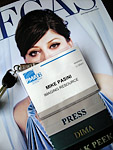 By MIKE PASINI
By MIKE PASINIEditor
The Imaging Resource Digital Photography Newsletter
LAS VEGAS -- The floor was a lot quieter on the last day of the show, but everyone we talked to (exhibitors and visitors alike) told us it was the best PMA they'd ever attended. It seems like the smaller crowds led to longer conversations and more business being conducted.
We used the last day lull to spend some time with an intriguing new rangefinder, a fast long zoom, some very fast memory cards and a monitor that made us drool.
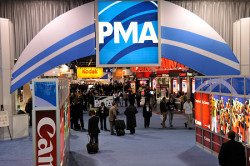
PMA on Saturday. The crowd thins.
Then we got down to a little business of our own, hitting the bag booths for a better solution to our needs. It was quite a trip, as you'll see below.
Sigma's long-awaited DP1 rangefinder (http://www.sigmaphoto.com) with a dSLR-sized Foveon X3 sensor was alive and kicking at the Sigma booth. You can expect to see it shipping in March, we were told, for $800. Laurence Matson gave us a little demo of the pocketable camera with a 28mm fixed focal length lens and ISO 800.
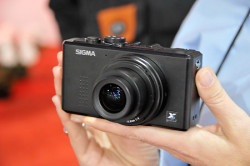
Sigma DP1. Foveon rangefinder.
He's been using it himself for a while now, taking it and his dSLR along with him where ever he goes. The trick, he said, is to see how long he can shoot with the DP1 before he feels the need to reach into his bag for the dSLR. "A long time," he smiled.
With a 1/2000 shutter and 16:9 aspect ratio, the camera stores its 320x240 30-fps movies in AVI format.
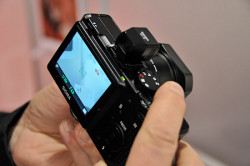
Rear View. Note the optional optical viewfinder.
We liked its light weight (you can indeed pocket the thing without leaning over, like the Canon G9 makes us do) and the accessories, which include an optical viewfinder that slips into the hot shoe and a compact flash with a guide number of 14 that takes two AAs.
But it is a peculiar little beast, starting with that fixed focal length wide angle lens, top ISO of only 800 and a dedicated manual focus ring (rather than a more versatile command dial) on the top panel. Autofocus is a bit peculiar too, requiring a trip to the menu system to set which of nine areas in the scene to target for focus. Might as well just set it on the center one, half press and recompose, no?
Casio's EX-F1 (http://www.casio.com) was a hit a Macworld Expo last month thanks to its fast frame rate. That includes fast flash, too, to keep up with it, as our video segment demonstrates.
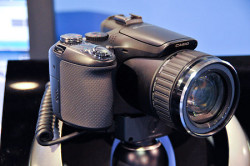
Casio EX-F1. Machine gun speed.
The secret to the SLR-like EX-F1 is its high-speed six megapixel CMOS sensor, capable of shooting at full resolution for up to 60 frames at 60 frames per second. You can adjust the burst-mode rate between 1 and 60 frames per second, trading off shooting speed for burst length up to the 60 frame burst limit.
That speed extends to movie mode, too, where you can capture 60 fields-per-second movies at 1920 x 1080 pixel resolution, and there are several lower-resolution movie modes that bring unusually high frame rates. At 512x384, for example, you can capture 300 fps, and at 432x192 you can get 600 fps. At 336x96 you can slow things down to 1,200 fps -- quite a change from the 30 fps of normal broadcast quality video.
The EX-F1 is no slouch is the Other Specs Dept. either with a 12x optical zoom lens, electronic viewfinder with 202K pixels, 2.8-inch LCD display with 230K pixels, Raw format capture and SD/MMC storage and you have a camera we're pretty sure Casio's got a winner on its hands.
That speed comes with a $1,000 price tag and will begin shipping in March.
As flash memory increases in capacity and decreases in price, the labels each brand is offering becomes mind-boggling. SanDisk (http://www.sandisk.com) for example now offers several high-end, very fast CompactFlash options.
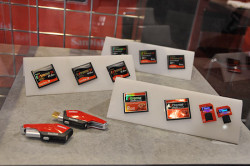
SanDisk Ducati Edition. Collectible speed.
The fastest is their limited edition Ducati label at 45 megabytes a second, available in 8-GB and 4-GB CompactFlash cards. The 4-GB Ducati Edition SD Plus folds open to reveal a USB 2.0 plug and can write at 20 MB/s, tops for an SD card. There's also a Ducati USB flash drive that echoes the fuel tank on a Ducati bike and can move 20-MB/sec. The "limited edition" concept is designed to make these cards not only fast but collectable. Keep an eye out for them on Antiques Roadshow.
Less collectible is SanDisk's Extreme IV line at 40 MB/s. The fast read/write speeds comes from the company's Enhanced Super-Parallel Processing technology. Compare that to the Extreme III line's 20 MB/s speed rating.
And no, they have no plans to add WiFi to an SD card. But then, we have to wonder how fast the Eye-Fi (that 2-GB card with WiFi) is. That little spec isn't on any of their product literature.
We'd been walking by the busy Eizo (http://www.eizo.com) booth all week but Saturday we actually got a chance to poke our nose in front of their newest wide-screen monitors. We had the luck of being there just as publisher Dave Etchells walked up. Not only is Imaging Resource anxious to start doing monitor reviews, but Dave was in the market for a few good displays for the lab.
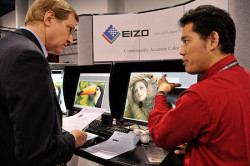
Eizo. Dave and Hidayuki discuss the ColorEdge CG222W (left).
Both of us were dazzled by the new ColorEdge CG222W featuring a wider color gamut and 12-bit hardware calibration. Its 1680x1060-pixel, 16:10 aspect ratio makes a luxurious desktop for still work as well as a convenient HD video workspace. Contrast ratio is 1000:1 and viewing angle is a wide 178 degrees both horizontally and vertically, so when you share the view others see what you see.
Like other Eizo monitors, the new CG222W bundles calibration software to set the brightness, white point and gamma using third-party devices (almost all of which will be supported by the time the monitor starts shipping in March). The hardware calibration ensures no color tones are lost in the calibration process, resulting in more accurate on-screen color. The monitor's 12-bit look-up table is used to calibrate the monitor in five minutes, saving the results as an ICC profile.
The wide gamut LCD panel reproduces 98 percent of the sRGB and 93 percent of the Adobe RGB color spaces. Available in March, it will list for $1,500.
Dave had and interesting conversation with Product Marketing Manager Hidayuki Honda about LED backlighting technology. At CES, ViewSonic introduced its $799 22-inch widescreen VLED221wm desktop monitor, features the world's first 12,000:1 dynamic contrast ratio in an LCD desktop display, according to the company. It can display 118 percent of the color gamut based on the National Television System Committee guidelines.
So was Eizo thinking about LED backlighting?
Not yet, Hidayuki said. They're already achieving 99/93 percent of the sRGB/Adobe color space now and LEDs introduce problems of their own. The biggest one is that they are an array of bulbs making it very hard to achieve consistent illumination across the panel. They also generate a lot more heat and result in a physically bigger monitor.
Eizo isn't ruling out an LED backlit display in the future, but the technology has to mature a bit more to make it into an Eizo monitor.
It's a good thing the show was shorter by half a day than prior ones. We got a little weary of our luggage. We used a Lowepro TZ1 to haul a Nikon D300 and Coolpix S510 around, but we also had to carry a notebook and transport things like business cards and product literature. The TZ1 was overworked.
And when our bag is overworked, we're overworked.
But we weren't really didn't know what to do. We realized we needed professional help, so we asked for it.
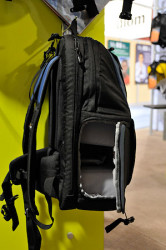
Lowepro Fastpack. A side door so you don't have to unzip the whole bag.
We started at the Lowepro booth (http://www.lowepro.com). The nurse made an appointment for us with Dr. Adam Croan who promptly tried to medicate us with the latest Fastpack and Flipside meds. The Fastpack is a backpack design with a side door through wide you can extricate your camera. The Flipside is a backpack that opens only on the side next to your back, so nothing can be "borrowed" when you aren't looking.
We are no fans of backpacks, though. That's partly because we're public transportation enthusiasts and have acquired a distinct dislike of the space-eating bags. People who carry them have no conception of how far they extend behind them and are constantly banging into seated passengers and other innocents. No, Doc, no backpack for us.
He suggested the Cirrus lunchbox style bag on us but that was more for transporting some gear to a party than it was for working a trade show. Maybe a belt on which we could hang accessory bags, he asked. Hmmm.
In the middle of our consult, however, he was called away to deal with a patient who only spoke Spanish. We were handed off to his colleague (and Lowepro bag designer) Pete Hill.
He suggested the Reza 170 and Stealth 100 shoulder bags and we took note of them. They reminded us a bit of our old Domke, which is just a tad too small for our latest gear.
On we went to the Mountainsmith booth (http://www.mountainsmith.com). We'd seen their latest products made of recycled plastic bottles at Sneak Peek and were curious if they could cure us while making us green, too.
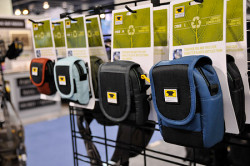
Mountainsmith Cyber II. How many bottles does it take to make a compact case?
Sam Bailey, something of a nurse practitioner, took us under her wing. First she explained that the recycling technology has quite a carbon footprint of its own. Plastic bottles are sent to Japan, which has developed the world's finest cleaning technology. If you don't wash out the bottle well, the impurities compromise the quality of the recycled fabric.
The fiber itself, however, is woven in China where the bags are assembled. You still can't substitute elastic and foam with recycled material, but the cloth is indeed recycled. On their smaller Cyber II recycled line, the company actually tells you how many bottles it took to make the bag. A little digicam case can take as many as three bottles.
Her suggestion was the Tour FX, a medium-sized bag, and the Aurora AT, which has a rubber bottom. Both of them were shoulder bags. Neither quite seemed as capable as our old Domke, though.
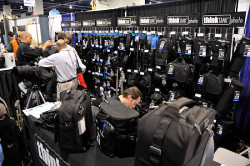
ThinkTank Booth. The belt approach.
We were about to give up when we wandered by the ThinkTank booth (http://www.thinktankphoto.com). They had a line that reminded us a bit of the belt system we saw at Lowepro, but greatly extended.
You could indeed hang the holster we fond of and a bag designed for an external flash, too. There were also pouches of various sizes for stuff like reporters' notebooks. They even have an energy bar bag. The belt idea appealed to us because it most resembles a desk, which is where we do most of our work, after all.
And to which we'll return for our show wrap-up report and our second annual PMA Envy awards. Stay tuned!